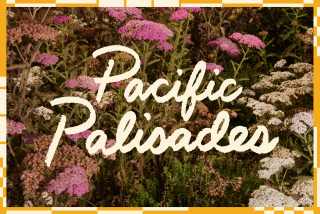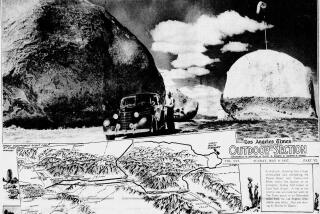Eccentrics, dreamers and seekers flock to Crestone, Colo.
For thousands of years, the high, arid San Luis Valley has spawned tales of the strange and the fantastic.
Native Americans called it the Bloodless Valley, setting aside their weapons as they made vision quests up sacred Blanca Peak, the great sentinel of the Sangre de Cristo Mountains whose bony spine winds dramatically from southern Colorado to Santa Fe, N.M.
Later inhabitants noted a peculiar energy attributed to a combination of wind, 8,000-foot altitude and an enormous aquifer beneath the highest high desert outside of Tibet. Some went further, claiming hidden UFO bases and mysterious portals where aliens enter and exit our world. All the while, the largest alpine valley on Earth became a magnet for eccentrics, dreamers and seekers.
People such as Cindy Santi — masseuse, tantric-yoga practitioner and bartender at the Laughing Buddha Lounge in remote Crestone.
Shortly after I wandered in, she offered me a shot of Ormus, a milky drink not unlike seawater.
“It’ll balance the left and right hemispheres of your brain,” she said.
As I pondered the white glop, Santi broke into an unprompted riff on the divine.
“I’m not into God, I’m into helpful not harmful, useful not useless,” she said. “So I don’t have any morals. I’m just living in the moment.”
I started to chime in, but she had moved on.
“When you hear the guitar, it’s all sex; that’s where the energy is coming from,” she continued. “Anyone who plays the guitar knows that.”
That drink was looking better, so I slugged it back — oddly refreshing with hints of low tide.
“You know what they say about Crestone, don’t you?” Santi asked. “We’re here because we’re not all there.”
With barely 1,500 inhabitants, this ruggedly handsome town four hours south of Denver, near the Great Sand Dunes National Monument, has emerged as one of the major spiritual centers of North America.
Home to some 23 religious retreats, Crestone allows you to spend weeks working on an ashram, studying Buddhism, ruminating on Taoism or soaking up the quiet of a desert hermitage. It’s a vast spiritual buffet where dilettante and serious practitioner easily rub chakras. And if things go horribly wrong, it’s one of the few places outside India where you can get cremated on a funeral pyre.
I drove into the Baca Grande, the huge chunk of mountain and forest where most residents and retreats are found, on a warm November afternoon. Deer lazily walked in front of my car. A group of teenagers gently shooed a reluctant herd from a basketball court.
Barely a mile in, I spotted the Stupa of Enlightenment with gray, spiraling peaks rising behind.
Anthony Reis circled the towering Buddhist monument.
“So much of the Southwest is like this —a gate or vortex or whatever you want to call it,” said the self-described healer from Santa Fe. “I think all of that energy is concentrated in Crestone. You can experience a rock, a bush, a tree more intensely. This place talks to you.”
Reis, 65, was headed for a retreat at the Vajra Vidya Tibetan Buddhist center, and I went along. The retreat sat amid a canopy of juniper and pine, light filtering through fluttering prayer flags. A grand doorway led to a temple adorned with golden Buddhas and images of fierce deities.
Ani Seltong Dronma, a Buddhist nun by way of Kansas, greeted me in the kitchen.
“To really ripen and deepen in your practice, you pretty much have to be in a situation like this removed from ordinary life,” she said. “That is the hallmark of all religious traditions.”
I wandered into the temple to hear a class taught by scholar David Fuqua.
“Everything is beginning and ending at every moment,” he said gently. “Everything is impermanent so we have to reconstruct our world over and over again all the time.”
While I tried to comprehend the details, Gabrielle Herbertson, from Questa, N.M., grasped the big picture.
“When you come here, you realize you are in the presence of something that is a blessing,” she told me. “You are in the presence of compassion.”
Crestone began as a mining community in 1880. In 1978, Canadian millionaire and former undersecretary general of the United Nations Maurice Strong and his wife, Hanne, bought the 200,000-acre Baca Ranch next to town.
“They wanted to do a different kind of development,” said Mark Elliot, a British documentary filmmaker who moved in 22 years ago. “So they started giving land to religious groups.”
The lure of free land and the haunting, Himalayan-like beauty attracted spiritual leaders from as far away as Tibet and Bhutan. Others fleeing urban or suburban America flowed in looking to start anew.
“It was the best thing that ever happened to me,” Elliot said. “It was a wonderful place to raise my son. And if you are a practicing Buddhist, there is no better place to be than Crestone.”
He urged me to visit the 41-foot-high Tashi Gomang Stupa, containing relics of the Buddha himself. I drove up a badly rutted road, briefly stopping by a cascading brook with prayer flags strung across the water.
Andrea Joy Cohen, a doctor from Denver, sat there reveling in mountain and sun.
“I had heard about Crestone so I wanted to come and see it,” she said. “I met a man in the forest who said this spot was sacred. I get the feeling people like that aren’t uncommon here.”
After more hairpin turns, I reached the magnificent stupa and marveled at the view — miles of desert stretching to snow-capped peaks beyond. Dirt paths led to hidden meditation retreats, and signs urged quiet.
By then it was nearly dusk, the Sangre de Cristo, or Blood of Christ, mountains were turning crimson, and I had a date at the Haidakhandi Universal Ashram to witness Diwali, the festival of lights.
The steps of the ashram were lined with candles burning in milk jugs. Inside, dozens of people sang traditional Hindu hymns accompanied by drum and harmonium, a keyboard with hand-pumped bellows.
“Hail, hail O king of sages, remover of the pain of thy devotees!” they sang, swaying ecstatically in the candlelight. A sweeping sense of joy filled the room, fueled by passionate tributes to Hindu gods sung almost entirely by non-Hindus.
I tracked down one of the singers, Alycia Chambers, in the kitchen. Her story, as I would discover, was typical Crestone.
“We lived in a tepee for nine years, moved into a yurt, and now we are up to a straw bale,” said the midwife and organic farmer. “It’s not easy living here. Everyone has two or three jobs, but you just simplify. It feels saner than the rest of the world.”
I spent the night at the ashram and woke the next morning to find Ramloti, 61, the president, doing yoga in the dark. She was born Debra Wood in the San Fernando Valley and moved to an ashram in India, where she was dubbed Ramloti, or “caring vessel of God.”
“People find love here and take it into the world,” she said. “You don’t need a church or temple. Everything you see is divine. Everything you see is God.”
I considered this as I headed for the Nada Hermitage, a Carmelite Catholic retreat wedged between mountain and desert.
A handful of people sat inside the sparsely furnished chapel, eyes closed. I took a seat in back. As the minutes crawled by, the roiling sea in my head reluctantly calmed.
An hour later, everyone opened their eyes.
“Lord shine on those who dwell in the darkness and the shadow of death,” they chanted before filing out.
I joined them in the kitchen.
“There has always been a desire to go back to more hermetic prayer — silence, solitude and wilderness — and that’s what we offer people,” said Father Eric Haarer.
The center rents nicely furnished cabins for those craving isolation.
“Not everyone would be at home with the stillness,” said lay leader Susie Ryan. “There are no filters. You are alone with your own thoughts. That’s a lot to deal with.”
My next stop was the Dharma Sangha Crestone Mountain Zen Center, a sprawling compound in a shady forest with a large meditation hall, dormitories and paths into the foothills.
“I am not interested in religion or spirituality,” said Christian Dillo, the preternaturally calm associate director. “I want to be outside of categories. By meditating, by stopping thinking, we can be in the world while experiencing this unique moment.”
It was a lot to digest — meditating in a desert chapel, contemplating impermanence, understanding the bliss of an empty mind and being swept up in ancient Indian hymns. Crestone was beginning to get under my skin.
I drove downtown to the Laughing Buddha, Crestone’s only saloon and a place teeming with warm characters.
There was Harriet Johns, an elderly painter who lives in a box car. “It was a refrigerator car so it’s insulated,” she said.
And Barbara Barnett, a deep trance channeler, who just got water pumped into her house. “Before that I just sort of showered around,” she explained.
Mayor Ralph Abrams scanned the menu, lingering briefly on the grass-fed yak burger before settling on a salad.
“This is not a commune, it’s not an intentional community, it just is,” he said. “The energy in this valley is what makes the spiritual practice so powerful.” |
But it’s also a hardscrabble place without the comforts of similar offbeat towns such as Ojai, Boulder, Colo., or Sedona, Ariz.
Abrams, who occasionally motors up the Amazon to consort with Peruvian shamans, welcomes seekers but warns against unrealistic expectations.
“As mayor I say, ‘Come,’ but it may not be what you think it is,” he said. “On the other hand, if you are not real, it may make you real.”
More to Read
Sign up for The Wild
We’ll help you find the best places to hike, bike and run, as well as the perfect silent spots for meditation and yoga.
You may occasionally receive promotional content from the Los Angeles Times.






